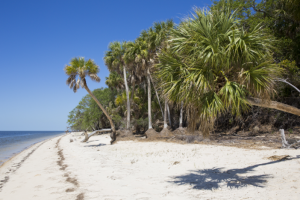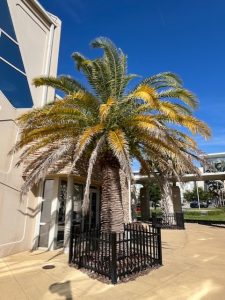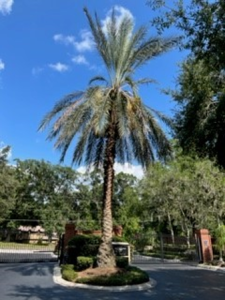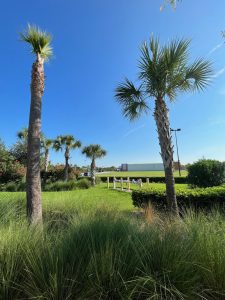 Let your palms sway! Most palms are well adapted for Florida’s humid sub-tropical climate. Palms have pinnate, palmate, or bipinnate leaves that dance in the wind and drip excess water off their leaf tips. The trunk stands strong like a concrete column, but with the ability to bend and adapt, rather than get snapped. It is no wonder palms thrive in Florida, with 11 palms native to the Sunshine State and innumerous non-native palms brought here by people looking to soak up the sun in their own paradisical backyards.
Let your palms sway! Most palms are well adapted for Florida’s humid sub-tropical climate. Palms have pinnate, palmate, or bipinnate leaves that dance in the wind and drip excess water off their leaf tips. The trunk stands strong like a concrete column, but with the ability to bend and adapt, rather than get snapped. It is no wonder palms thrive in Florida, with 11 palms native to the Sunshine State and innumerous non-native palms brought here by people looking to soak up the sun in their own paradisical backyards.

Leave the living leaves! Research and observations indicate that leaving a fuller palm canopy is healthier for the palm, especially after extreme weather events like hurricanes or freezes. It makes sense, all those palm fronds protect the single active growing point deep in the heart of the canopy.
Basic Palm Pruning Recommendations
In general, it is not recommended to prune living palm fronds. Those leaves are photosynthesizing powerhouses responsible for making the sugars the palm uses to grow. Also, certain disease can enter directly into the vascular system of the palm, leading to eventual decline and death.
However, the best practice needs to work realistically with maintenance schedules while maintaining a level of aesthetics. Therefore, according to our researchers, it is acceptable to prune palms up to the 9:00 – 3:00 level. I will warn that pruning to that 9 – 3 level removes your best diagnostic tools to read your palms, especially which nutrients they are hungry for. Certain palms show unattractive macro-nutrient deficiencies in their old leaves. Some of those leaves are just old and hanging on the palm naturally, but others are screaming for special palm fertilizer. If those lower leaves are continually pruned off, the discoloration and browning may progress above the 9 – 3 level, which everyone agrees is not ideal.
It is fine to remove flowers and fruits. If the palm is located in an area where flower and fruit drop will cause a mess, the flowers and fruits can be removed. Removing flowers and fruits is different than removing a leaf because flowers and fruits are an energy sink, so the palm is directing resources out of the palm. Leaves/fronds are energy sources, moving resources (and diseases) into the palm. If flower and fruit drop is not an issue where the palm is located in the landscape, consider leaving the flowers for pollinators and fruits for local wildlife. Bees working a palm inflorescence is a sight and sound to behold!

Never prune your palms to look like feather-dusters. This contributes to the decline and eventual death of the palm.
Palm Biology and Palm Pruning
Did you know there are self-pruning palms and non-self-pruning palms, otherwise known as crownshaft or non-crownshaft palms?
A healthy crownshaft palm will naturally shed the oldest leaf. It will take a few days to turn brown and then fall from the palm.
It sounds silly to say, but it is hard to appreciate how humongous palm fronds can be until they have to be dragged away.
In most residential landscapes, you can just let the leaf fall. In most commercial landscapes, due to the threat of the large palm leaves falling on ornamental landscapes, in the road, or on a car, professionals may need to carefully remove the oldest palm frond with pruning tools without accidentally cutting into the trunk.

If the crownshaft palm has more than that single lower leaf looking discolored, your palm might be hangry for a pH adjustment and special palm fertilizer. A healthy palm without a crownshaft will maintain a skirt of brown leaves, and these palms make a variety of fashion statements. Some palms look stunning with a petticoat of brown leaves cascading down the trunk. Other palms look like they needed a haircut of those brown fronds last week. In many cases, keeping or pruning those dead leaves is a matter of personal preference and tolerance. There is a science to this, too! The best way to keep your palms healthy is not to prune living palm fronds.
Check out this UF/IFAS EDIS document for more detailed information about Pruning Palms!
Special thanks to Dr. Mica McMillan for connecting the science to the acceptable maintenance practices.
 3
3
